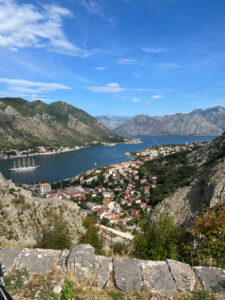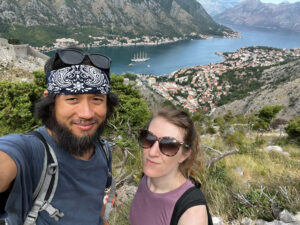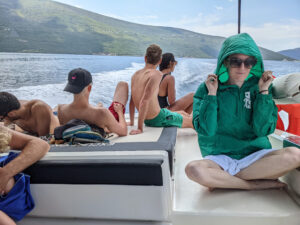
After seeing Bosnia, I thought that the rest of the Balkans would be similar to it—a wilder and more foreign version of the Europe I’d seen before. We were solidly in the land of mildly-sketchy public transportation, cash-only establishments in currencies that were hard to keep track of, and languages that some people swore were different while others promised were exactly the same but with different names. I knew Montenegro got more tourism than Sarajevo and Mostar because of its location on the coast. The Bay of Kotor is a cruise ship port, and it’s close enough to Dubrovnik, Croatia, that people go as a day trip. The hostel I’d booked for us in advance was the most expensive one I’d booked in the Balkans, so I knew everything else would probably be comparably more expensive, too. But I was surprised at just how much tourism we found.
We stayed in the town of Kotor, which is in the farthest corner of the Bay of Kotor and surrounded by rocky mountains that look like they might topple over at any moment. The Old Town used to be a palace, and right behind the Old Town where the former palace walls meet the hillside, you can climb up to what’s left of the fortress and see a postcard-view of the entire bay. The Old Town is full of cobble stones, church bells, stray cats, and gelato that claims to be organic. It’s pristine and beautiful, but the kind of beautiful that you can feel has been manufactured for tourism. If Disney set a movie in Montenegro, they would design it to look exactly like this.
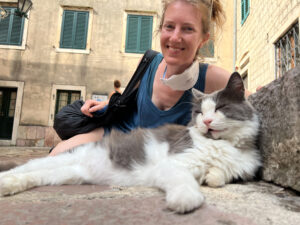
And while I expected more tourism than we’d seen in Serbia or Bosnia, I did not expect the degree to which I felt like we were solidly back in the West. Our hostel manager was a friendly but jaded guy who admitted he didn’t plan to do the job much longer. The hostel balcony overlooked the water polo pool where the national team practices every day and where he himself used to play when he was younger. We watched the professional team swim laps as he told us about how the town has changed. Every day during peak season, up to 5 cruise ships port here. And this is NOT a town that can hold 20,000 extra people. Restaurants here mostly serve the same (western) food for the same (expensive) prices. Prices have risen so much over the past 10 years that locals can’t afford to live in town anymore. Unlike most other countries in the Balkans, it uses the Euro, which makes it feel even more like the West.
In our 3 days in Kotor, Michael and I climbed the fortress and the mountain path behind it for views. We took a speedboat tour across the bay to the Lady of the Rocks, which is a tiny little church that sits on a manmade island in the middle of the bay. They decided there had to be a church there when local people found a magically unharmed painting of the Virgin Mary in the water, and they thought it was a sign from God that a church needed to sit in the spot where they found it. They sank a bunch of boats and piled rocks on top of each other until they had an island big enough to build the church on. We saw the submarine tunnels leftover from the Cold War, and then we went out to the Adriatic Sea and swam next to the Blue Cave in some of the bluest water I’ve ever seen. It was my first time touching the Adriatic. We randomly met a lady who used to be a literary agent and invited her to join us while we ate lunch. We got to pet a lot of stray dogs. We slowed down in Kotor, and it was a great place to rest.
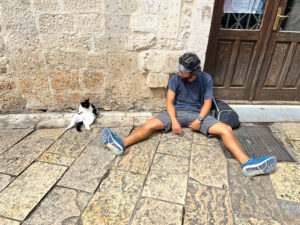
But I felt conflicted about being there as a tourist so close to tourist season when I knew how much damage the tourism industry is doing to the area. Right behind the pool where the water polo team practices, a bulldozer was clearing land for a fancy new hotel. It’s next to the picnic table where our hostel manager has sat and played his music every night since he was a teenager. He feels like the tourists are taking it from him.
I think a lot of people find there to be a big distinction between the stereotypical obnoxious “tourists” and the worldly “travelers.” I even find myself making such judgements accidentally. On one hand, I get it—I do feel that there is a difference in the intention of different types of travelers. I have a good laugh at the things I deem to be “silly tourist traps” and the people who fall victim to them, or worse, seek them out. But the truth is, we’re all tourists. A person who travels to see a foreign place is, by definition, a tourist. And there are a lot of ethical questions and responsibilities that come with being a tourist that I don’t have easy answers for. There are tourists who look down on anyone visiting on a day excursion from a cruise ship but find no qualms with doing the same day-excursion activities themselves as long as they took a bus to get there. There are purists who think that if you’re spending more than $20 per day and not hitchhiking, you’re not a real backpacker. There are weird and arbitrary standards that maybe we all accidentally set in our minds to make ourselves feel like we’re on the right side of an issue. (My ex-boyfriend told me that he didn’t find me to be adventurous. It’s interesting how different such standards are for all of us.)
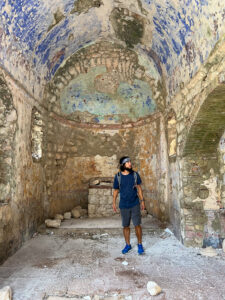
Kotor made me think a lot about the ethical questions of tourism. Later Croatia would make me think even more about it. Tourism has benefited people here in that it’s brought wealth and jobs to the region, but at what cost? Was it worth it if local people can’t afford to live here anymore? Maybe some of them would say so if it means they have more reliable jobs that pay well? Maybe others would say they miss when their beautiful home was just theirs. How do we avoid turning places like Kotor into places like Venice—a place in danger of no longer existing because of the impact of over-tourism? That’s not an urgent problem for Kotor yet, and won’t be for a long time, but isn’t it already too late if we wait until it’s urgent to think about it?

